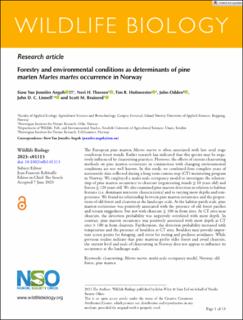Forestry and environmental conditions as determinants of pine marten Martes martes occurrence in Norway
Angoh, Siow Yan Jennifer; Thorsen, Neri Horntvedt; Hofmeester, Tim R.; Odden, John; Linnell, John Durrus; Brainerd, Scott Michael
Peer reviewed, Journal article
Published version
Permanent lenke
https://hdl.handle.net/11250/3084990Utgivelsesdato
2023Metadata
Vis full innførselSamlinger
Sammendrag
The European pine marten Martes martes is often associated with late seral stage coniferous forest stands. Earlier research has indicated that this species may be nega tively influenced by clearcutting practices. However, the effects of current clearcutting methods on pine marten occurrence in conjunction with changing environmental conditions are not well known. In this study, we combined four complete years of nationwide data collected during a long-term camera trap (CT) monitoring program in Norway. We employed a multi-scale occupancy model to investigate the relationship of pine marten occurrence to clearcuts (regenerating stands ≤ 10 years old) and forests ≥ 120 years old. We also examined pine marten detection in relation to habitat features (i.e. dominant microsite characteristics) and to varying snow depths and temperatures. We found no relationship between pine marten occurrence and the proportions of old forest and clearcuts at the landscape scale. At the habitat-patch scale, pine marten occurrence was positively associated with the presence of old forest patches and terrain ruggedness, but not with clearcuts ≤ 100 m from sites. At CT sites near clearcuts, the detection probability was negatively correlated with snow depth. In contrast, pine marten occurrence was positively associated with snow depth at CT sites > 100 m from clearcuts. Furthermore, the detection probability increased with
temperature and the presence of boulders at CT sites. Boulders may provide impor tant access points for foraging, and cover for resting and predator avoidance. While previous studies indicate that pine martens prefer older forest and avoid clearcuts, the current level and scale of clearcutting in Norway does not appear to influence its occurrence at the landscape scale.

